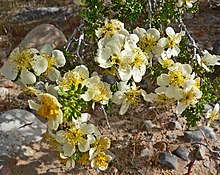Bitterbrush
| Purshia | |
|---|---|
 |
|
| Purshia stansburyana | |
| Scientific classification | |
| Kingdom: | Plantae |
| (unranked): | Angiosperms |
| (unranked): | Eudicots |
| (unranked): | Rosids |
| Order: | Rosales |
| Family: | Rosaceae |
| Subfamily: | Dryadoideae |
| Genus: |
Purshia DC. ex Poir. |
| Type species | |
|
Purshia tridentata |
|
| Species | |
|
See text |
|
 |
|
See text
Purshia (bitterbrush or cliff-rose) is a small genus of 5-8 species of flowering plants in the family Rosaceae, native to western North America, where they grow in dry climates from southeast British Columbia in Canada south throughout the western United States to northern Mexico. The classification of Purshia within the Rosaceae has been unclear. The genus was originally placed in the subfamily Rosoideae, but is now placed in subfamily Dryadoideae.
They are deciduous or evergreen shrubs, typically reaching 0.3–5 m tall. The leaves are small, 1–3 cm long, deeply three- to five-lobed, with revolute margins. The flowers are 1–2 cm diameter, with five white to pale yellow or pink petals and yellow stamens. The fruit is a cluster of dry, slender, leathery achenes 2–6 cm long. The roots have root nodules that host the nitrogen-fixing bacterium Frankia.
The evergreen species were treated separately in the genus Cowania in the past; this genus is still accepted by some botanists.
P. tridentata, Lava Beds National Monument
P. stansburiana, Red Rock Canyon, Nevada
P. stansburiana, Red Rock Canyon, Nevada
...
Wikipedia
